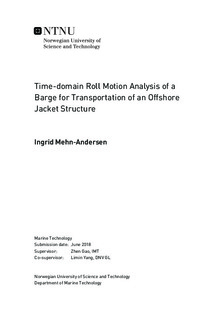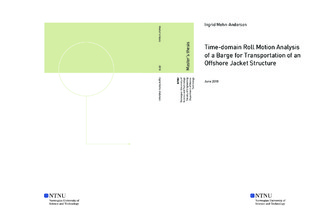| dc.description.abstract | This paper presents a literature study on roll motions for barges, and time domain and frequency domain simulations. In addition, results from time and frequency domains have been compered in regular and irregular waves to verify the stochastic linearization process preformed to linearize roll motion.
Most vessel responses can be calculated with acceptable accuracy in the frequency domain, whereas it is more difficult for roll response. This is due to roll motion being highly non-linear compared to other degrees of freedom. The non-linearity arises from flow separation. Estimating roll damping is therefore associated with difficulties and uncertainty. Consequently, empirical formulas have been developed for classical ship shapes (Ikea et al. 1977). In addition, roll natural period generally falls within the frequency range of a typical wave energy spectrum. This causes dynamic amplification of roll motion. Hence it is of utmost importance that good estimation of roll damping is made for such structures.
The barge has zero forward speed in the time domain simulations. To achieve realistic results for a barge with forward speed, stiffness was added in surge, sway and yaw. A proper damping was also needed to avoid resonant motions in these DOFs. Due to coupled motions, the level of damping in sway had great impact on the roll motion. In order to achieve acceptable horizontal offset and steady state roll motion, a damping ratio of 1 \% was found to be optimal.
The stiffness in surge, sway and yaw were zero in HydroD, the system is therefore free to oscillate without restrictions in these DOFs, and no natural frequencies are found. The difference in the heave, roll and pitch may be due to coupled motions, where the damping in other degrees of freedom affects the damping in roll. Another reason can be differences in calculation processes between SIMA and HydroD. Two concrete examples are that SIMA uses the damped natural frequency instead of the natural frequency, and the added mass for infinity frequency instead of added mass corresponding to the natural frequency.
For regular waves, an iteration process in HydroD provided the linearized damping for regular waves with 45 degrees wave heading. In the comparison of the linearized and quadratic damping RAO's in SIMA and HydroD, similarities were observed for most frequencies. However, around the natural frequencies, differences were observed. All in all there is good consistency between the linearized and quadratic damping. This may be due to coupled effects or conservative results in the frequency domain analyzes.
The response spectra for roll motion in SIMA are compared with HydroD. One can see that the wave spectra from SIMA contain a peak at 0.1 [rad/s]. This coincides with the natural period in sway and is most likely due to the coupled motions. The form of the spectrum from HydroD is different from SIMA, the total energy from the methods was therefore compared using the standard deviation. In roll motion, the amount of energy appeared to be similar, however the energy contributes at different frequencies.
In SIMA different wave seeds were used, with the same environmental conditions. They turned out looking completely different. Because of large differences between analyses with equal conditions, it is advised to test more wave seeds. This is the only way one can be certain that a wide range of scenarios are tested, and the correct behaviour of the barge is recorded. | |

